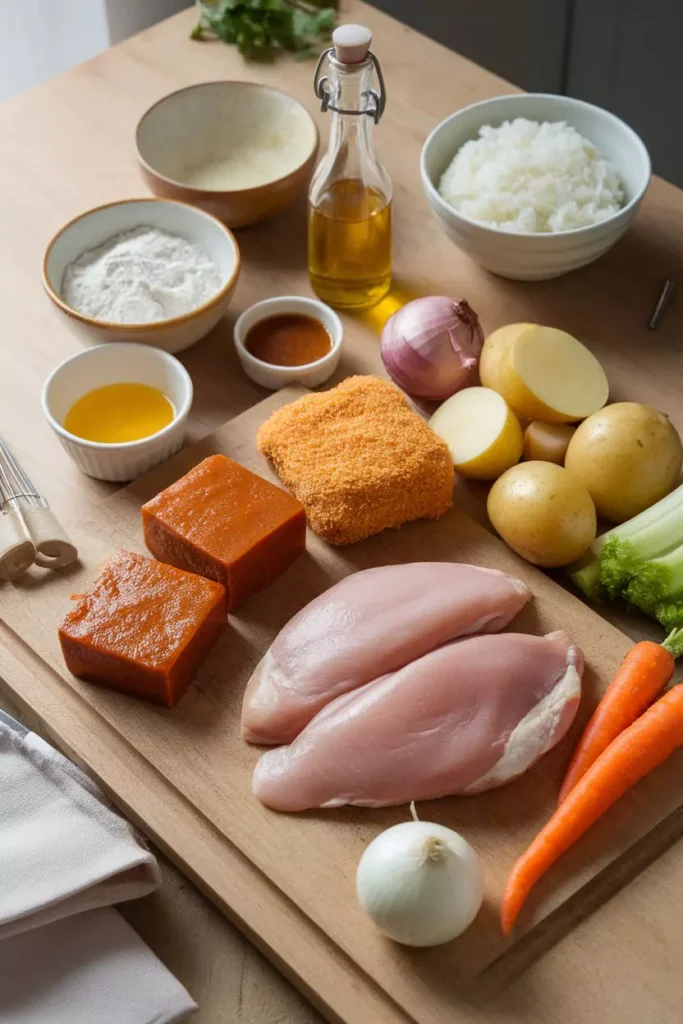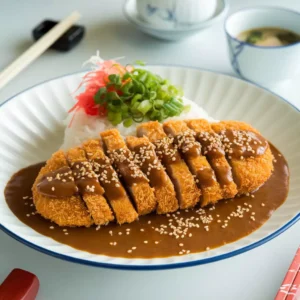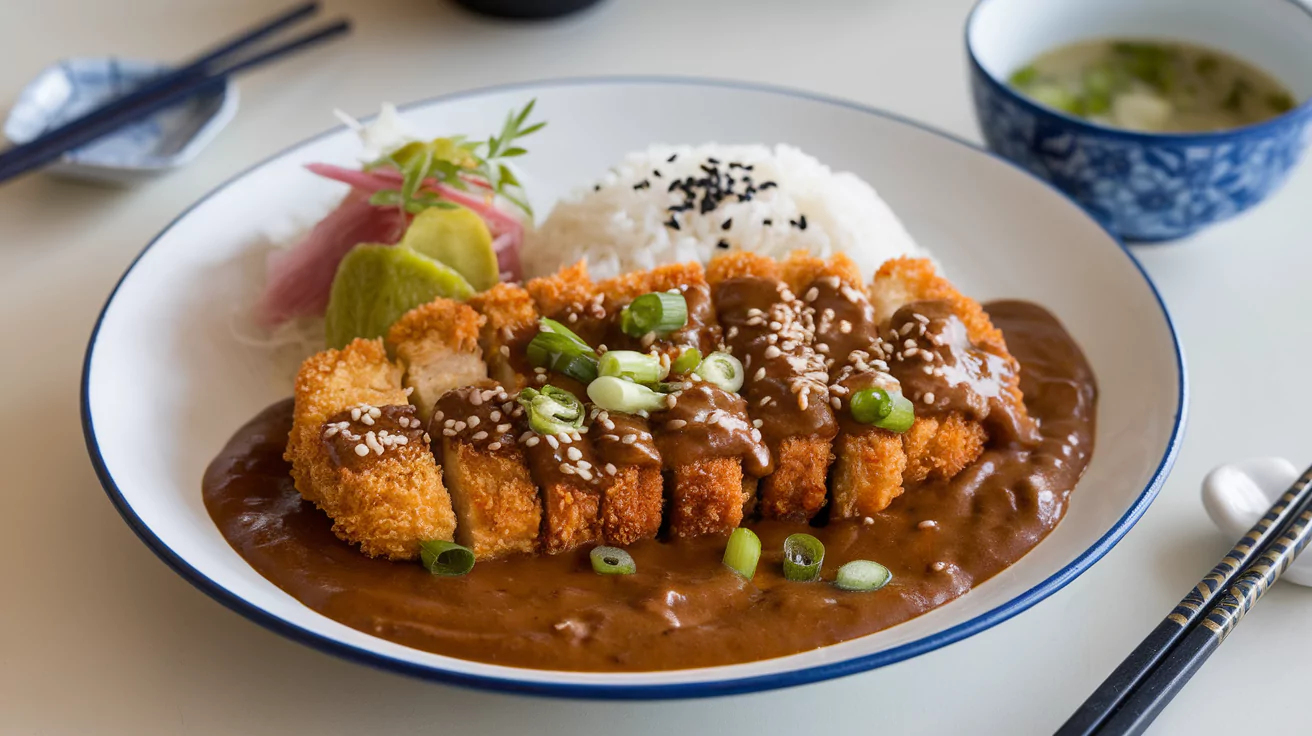Have you ever craved a meal that wraps you in warmth and comfort with every bite? Katsu curry does just that—a perfect harmony of crispy, golden chicken cutlets and a rich, velvety Japanese curry sauce served over steamed rice. This beloved dish isn’t just about incredible flavor; it’s about creating a heartwarming experience right in your kitchen.
Whether you’re new to Japanese cuisine or a seasoned home chef, this recipe is a game-changer. With simple ingredients like panko breadcrumbs and curry roux, you can recreate the authentic taste of a restaurant-quality katsu curry at home. Plus, it’s versatile enough to adapt to your preferences—think tofu for a vegetarian twist or adding your favorite veggies for extra flavor.
Ready to discover how this comforting classic can become your new favorite dish? Let’s dive in!
Key Benefits
Katsu curry isn’t just a meal; it’s an experience that combines the comfort of a hearty dish with the elegance of Japanese cuisine. Here’s why you’ll fall in love with it:
- Ultimate Comfort Food: The crispy panko-coated cutlet paired with a warm, savory curry sauce creates a satisfying balance of textures and flavors. It’s perfect for cozy nights or when you need a pick-me-up.
- Versatile and Customizable: Whether you stick with the classic chicken cutlet or experiment with tofu, pork, or even seafood, this recipe adapts beautifully to your preferences. You can also add your favorite veggies for extra nutrition and flavor.
- Easy to Make at Home: Recreating restaurant-quality katsu curry at home is simpler than you think. With the right ingredients and a few helpful tips, you’ll have a dish that rivals your favorite takeout.
- Crowd-Pleasing Appeal: From family dinners to casual gatherings, this dish is a hit with everyone. Its familiar flavors and comforting aroma make it universally loved.
Whether you’re cooking for yourself or sharing it with loved ones, katsu curry has a way of making every mealtime feel special. Now that you know why this dish deserves a spot in your recipe repertoire, let’s get started!
Ingredients

Gathering the right ingredients is the first step to creating the perfect katsu curry. Here’s what you’ll need to bring this dish to life:
For the Crispy Cutlet
- Chicken breast or pork loin: Choose boneless, skinless cuts for easy preparation. Alternatively, use tofu or eggplant for a vegetarian option.
- Panko breadcrumbs: These light, flaky breadcrumbs are key to achieving that golden, crispy coating.
- All-purpose flour: Helps the breading stick to the cutlet.
- Eggs: Whisked to create the glue that binds the breadcrumbs to the meat.
- Salt and pepper: For seasoning the meat before breading.
For the Curry Sauce
- Curry roux blocks: These pre-made blocks are a convenient way to achieve an authentic Japanese curry flavor. Look for brands like Golden Curry or Vermont Curry.
- Onion: Sliced thinly to add sweetness and depth to the sauce.
- Carrot and potato: Classic additions for a hearty, chunky curry.
- Garlic and ginger: Freshly minced for a fragrant base.
- Chicken or vegetable stock: Adds richness and helps achieve the perfect sauce consistency.
For Serving
- Steamed rice: Short-grain or medium-grain rice works best for soaking up the curry sauce.
- Pickled vegetables (optional): Adds a tangy contrast to the rich flavors.
- Fresh herbs (optional): Garnish with chopped parsley or green onions for a pop of color.
Pro Tip
Make sure your ingredients are prepped and ready before you start cooking—this makes the process smoother and more enjoyable. Now that you’ve got everything you need, it’s time to bring this dish together!
How to Make Katsu Curry

Crafting the perfect katsu curry at home is easier than you might think. Follow these straightforward steps to create a dish that’s crispy, flavorful, and irresistibly comforting.
Step 1: Prepare the Cutlet
- Choose your protein: Use chicken breast, pork loin, or tofu for a vegetarian twist. Lightly pat it dry to help the breading stick.
- Season well: Sprinkle both sides of your protein with salt and pepper to enhance the flavor.
- Set up your breading station: Arrange three shallow bowls—one with flour, one with beaten eggs, and one with panko breadcrumbs.
- Bread the cutlet: Coat the protein in flour, dip it into the beaten egg, and press it firmly into the panko breadcrumbs. Make sure it’s fully covered for that signature crunch.
- Fry to perfection: Heat oil in a skillet over medium heat. Fry each piece until golden brown and crispy, about 3-4 minutes per side. Place the cooked cutlets on paper towels to absorb excess oil.
Step 2: Make the Curry Sauce
- Sauté the base: Heat a drizzle of oil in a saucepan and sauté minced garlic, grated ginger, and thinly sliced onion until soft and fragrant.
- Add the vegetables: Stir in chopped carrots and potatoes. Cook for a few minutes to develop their flavors.
- Simmer with stock: Pour in chicken or vegetable stock, bringing the mixture to a gentle simmer. Let it cook until the vegetables are tender, about 15 minutes.
- Incorporate the roux: Break the curry roux into chunks and stir them into the pot. Keep stirring until the sauce thickens and becomes velvety smooth. Adjust the consistency with a little extra stock, if needed.
Step 3: Bring It All Together
- Prepare the rice: Cook and fluff steamed short-grain rice for the perfect accompaniment.
- Slice the cutlet: Let the cutlets rest for a minute before slicing them into strips. This helps keep the breading intact.
- Assemble the dish: Arrange the rice and cutlet on a plate, then generously ladle the curry sauce over or beside the cutlet.
Pro Tip
For an added burst of flavor, garnish with chopped scallions, sesame seeds, or a side of pickled vegetables. Want a healthier twist? Try air-frying or baking the cutlet for a lighter version without sacrificing crunch.
With these steps, you’ll create a katsu curry that’s not just delicious but also a joy to make. It’s comfort food done right, ready to warm your heart and soul!
Pro Tips and Variations
A few clever tips and creative variations can transform your katsu curry from simply delicious to absolutely unforgettable. Here’s how to fine-tune your recipe and customize it to your liking.
Pro Tips for Perfect Katsu Curry
- Achieve the ultimate crunch: Use fresh panko breadcrumbs for a crispier texture. Toast them lightly in a dry pan before breading for an extra layer of golden goodness.
- Oil temperature matters: Maintain the frying oil at a steady 350°F (175°C) to ensure your cutlet cooks evenly and doesn’t absorb too much oil.
- Slice with care: Use a sharp knife to cut your fried cutlet into strips. This prevents the breading from separating and keeps each slice picture-perfect.
- Customize the spice level: Add more curry roux for a bolder flavor or dilute with stock if you prefer a milder sauce. You can also add a dash of soy sauce for depth or a bit of honey for sweetness.
- Time-saving hack: Prepare your curry sauce and cutlet breading in advance. Refrigerate separately and fry the cutlets fresh just before serving.
Creative Variations
- Vegetarian Delight: Swap the chicken or pork with firm tofu, sliced eggplant, or hearty portobello mushrooms. For extra crunch, double-coat your vegetable slices before frying.
- Spicy Fusion: Mix a teaspoon of garam masala or red chili powder into the curry sauce for a fusion of Japanese and Indian flavors.
- Seafood Option: Bread and fry shrimp or fish fillets to create a coastal twist on the classic dish.
- Healthy Alternative: Use an air fryer or bake the cutlets in the oven for a lighter version without compromising the crispy coating.
- Extra Veggies: Add broccoli florets, zucchini, or snap peas to the curry for a colorful, nutrient-packed meal.
Pro Serving Tip
Don’t forget the finishing touches! A sprinkle of sesame seeds, a drizzle of tonkatsu sauce, or a few pickled vegetables on the side can elevate your katsu curry to the next level. Pair it with a refreshing green salad or a bowl of miso soup for a complete meal.
With these tips and variations, you’ll master the art of katsu curry and make it uniquely yours. Whether you stick to the classic recipe or experiment with new flavors, every version is sure to be a hit!
Serving Suggestions
The beauty of katsu curry lies in its versatility and the comfort it brings to any table. Here are some simple yet thoughtful serving ideas to ensure your dish is as visually appealing as it is delicious.
Classic Presentation
- Steamed Rice: Serve your katsu curry with a generous portion of warm, fluffy steamed short-grain rice. The rice perfectly complements the rich curry sauce and crispy cutlet.
- Layer and Garnish: Plate the rice first, arrange the sliced cutlet on top or beside it, and generously ladle the curry sauce over the dish. Finish with a sprinkle of sesame seeds or chopped scallions for a professional touch.
Side Dishes to Elevate the Meal
- Pickled Vegetables: Add a side of pickled ginger or daikon radish for a tangy contrast to the savory flavors.
- Green Salad: A light salad with a sesame or miso dressing adds a refreshing crunch.
- Miso Soup: A warm bowl of miso soup with tofu and seaweed creates a traditional Japanese pairing.
Family-Style Sharing
For a family dinner or a casual gathering, serve katsu curry in a large dish. Keep the rice, curry sauce, and cutlets separate so guests can assemble their own plates. This makes it interactive and ensures everyone gets their preferred portion.
Creative Plating Ideas
- Bento-Style Presentation: For a fun twist, present your katsu curry in a bento box with compartments for rice, curry, and small sides like pickles or edamame.
- Layered Bowls: Serve the dish in a deep bowl, layering the rice, curry, and cutlet for a cozy, one-dish meal.
- Garnish for Color: Add a pop of color with fresh herbs like parsley, thinly sliced red chilies, or a wedge of lime on the side.
Pro Tip
If you’re serving guests, warm the plates or bowls before plating the dish. This keeps the curry and rice warm for longer, enhancing the overall dining experience.
Whether you’re keeping it simple or dressing it up, katsu curry is a dish that brings warmth and joy to any meal. Take your time to plate it beautifully, and watch as your creation becomes an instant crowd-pleaser!
Conclusion
Katsu curry isn’t just a recipe; it’s a heartfelt journey into the world of comforting Japanese cuisine. From the crispy, golden cutlets to the rich, velvety curry sauce, every element of this dish is designed to delight your senses and satisfy your cravings.
By following the steps in this guide, you’ve mastered the art of blending textures and flavors into a meal that feels both indulgent and homely. Whether you’re treating yourself to a cozy dinner or impressing friends and family, katsu curry is a dish that always leaves a lasting impression.
The best part? It’s endlessly versatile. From trying vegetarian alternatives like tofu and eggplant to experimenting with spicier sauces or additional toppings, you can make katsu curry uniquely yours every time you prepare it.
We hope this recipe brings as much joy to your kitchen as it does to your table. Don’t forget to share your creations, favorite variations, or any tips you’ve discovered along the way. Cooking is always better when it’s shared, after all!
So grab your plate, take that first bite, and enjoy the warmth and love that katsu curry brings to every meal. Until next time, happy cooking!

Katsu Curry
Ingredients
For the Crispy Cutlet
- Chicken breast or pork loin: Choose boneless skinless cuts for easy preparation. Alternatively, use tofu or eggplant for a vegetarian option.
- Panko breadcrumbs: These light flaky breadcrumbs are key to achieving that golden, crispy coating.
- All-purpose flour: Helps the breading stick to the cutlet.
- Eggs: Whisked to create the glue that binds the breadcrumbs to the meat.
- Salt and pepper: For seasoning the meat before breading.
For the Curry Sauce
- Curry roux blocks: These pre-made blocks are a convenient way to achieve an authentic Japanese curry flavor. Look for brands like Golden Curry or Vermont Curry.
- Onion: Sliced thinly to add sweetness and depth to the sauce.
- Carrot and potato: Classic additions for a hearty chunky curry.
- Garlic and ginger: Freshly minced for a fragrant base.
- Chicken or vegetable stock: Adds richness and helps achieve the perfect sauce consistency.
For Serving
- Steamed rice: Short-grain or medium-grain rice works best for soaking up the curry sauce.
- Pickled vegetables optional: Adds a tangy contrast to the rich flavors.
- Fresh herbs optional: Garnish with chopped parsley or green onions for a pop of color.
Pro Tip
- Make sure your ingredients are prepped and ready before you start cooking—this makes the process smoother and more enjoyable. Now that you’ve got everything you need it’s time to bring this dish together!
Instructions
Step 1: Prepare the Cutlet
- Choose your protein: Use chicken breast, pork loin, or tofu for a vegetarian twist. Lightly pat it dry to help the breading stick.
- Season well: Sprinkle both sides of your protein with salt and pepper to enhance the flavor.
- Set up your breading station: Arrange three shallow bowls—one with flour, one with beaten eggs, and one with panko breadcrumbs.
- Bread the cutlet: Coat the protein in flour, dip it into the beaten egg, and press it firmly into the panko breadcrumbs. Make sure it’s fully covered for that signature crunch.
- Fry to perfection: Heat oil in a skillet over medium heat. Fry each piece until golden brown and crispy, about 3-4 minutes per side. Place the cooked cutlets on paper towels to absorb excess oil.
Step 2: Make the Curry Sauce
- Sauté the base: Heat a drizzle of oil in a saucepan and sauté minced garlic, grated ginger, and thinly sliced onion until soft and fragrant.
- Add the vegetables: Stir in chopped carrots and potatoes. Cook for a few minutes to develop their flavors.
- Simmer with stock: Pour in chicken or vegetable stock, bringing the mixture to a gentle simmer. Let it cook until the vegetables are tender, about 15 minutes.
- Incorporate the roux: Break the curry roux into chunks and stir them into the pot. Keep stirring until the sauce thickens and becomes velvety smooth. Adjust the consistency with a little extra stock, if needed.
Step 3: Bring It All Together
- Prepare the rice: Cook and fluff steamed short-grain rice for the perfect accompaniment.
- Slice the cutlet: Let the cutlets rest for a minute before slicing them into strips. This helps keep the breading intact.
- Assemble the dish: Arrange the rice and cutlet on a plate, then generously ladle the curry sauce over or beside the cutlet.
Pro Tip
- For an added burst of flavor, garnish with chopped scallions, sesame seeds, or a side of pickled vegetables. Want a healthier twist? Try air-frying or baking the cutlet for a lighter version without sacrificing crunch.
- With these steps, you’ll create a katsu curry that’s not just delicious but also a joy to make. It’s comfort food done right, ready to warm your heart and soul!
Notes
Nutrition Information (Per Serving)
- Calories: 650 kcal
- Fat: 25g
- Saturated Fat: 4g
- Protein: 30g
- Carbohydrates: 75g
- Fiber: 5g
- Sugar: 8g
- Sodium: 850mg
FAQs
To help you perfect your katsu curry, here are answers to some common questions. Whether you’re a first-timer or looking to refine your technique, these tips will ensure a smooth cooking experience.
Can I make katsu curry vegetarian or vegan?
Absolutely! Swap out the meat for firm tofu, eggplant slices, or even sweet potatoes for a vegetarian version. For a vegan twist, use a plant-based curry roux and replace the eggs with a flaxseed or aquafaba substitute during breading.
How do I store and reheat leftovers?
Store leftover katsu curry in an airtight container. Keep the cutlets separate from the curry sauce to maintain their crispiness. Reheat the curry in a saucepan over low heat, adding a splash of stock if needed to loosen the sauce. Warm the cutlets in the oven or air fryer to restore their crunch.
Can I prepare katsu curry without curry roux?
Yes! You can make a homemade curry roux using flour, butter, and curry powder. Cook the flour and butter until golden, then stir in curry powder and gradually add stock until you reach the desired consistency.
What’s the best rice to serve with katsu curry?
Short-grain or medium-grain rice works best because it has a slightly sticky texture that pairs perfectly with the rich curry sauce. Japanese sushi rice or Calrose rice are great options.
Can I make the cutlets ahead of time?
Yes, you can! Bread the cutlets in advance and store them in the refrigerator for up to a day before frying. If you need to fry them earlier, reheat in the oven or air fryer to keep them crispy before serving.
What’s the difference between Japanese curry and other types of curry?
Japanese curry is milder and sweeter than Indian or Thai curries, with a thicker, gravy-like consistency. It’s typically less spicy and has a rich, comforting flavor profile that appeals to a wide range of tastes.
How do I adjust the spice level?
To increase the heat, add cayenne pepper, red chili powder, or even a splash of sriracha to the curry sauce. For a milder version, dilute the sauce with more stock or coconut milk.
What garnishes pair well with katsu curry?
Garnishes like sliced green onions, sesame seeds, pickled ginger, or a drizzle of tonkatsu sauce add a burst of flavor and elevate the dish’s presentation.
These FAQs should address most of your concerns, but don’t hesitate to experiment and make the recipe your own. After all, the joy of cooking lies in discovering what works best for you! Happy cooking and enjoy your delicious katsu curry!

